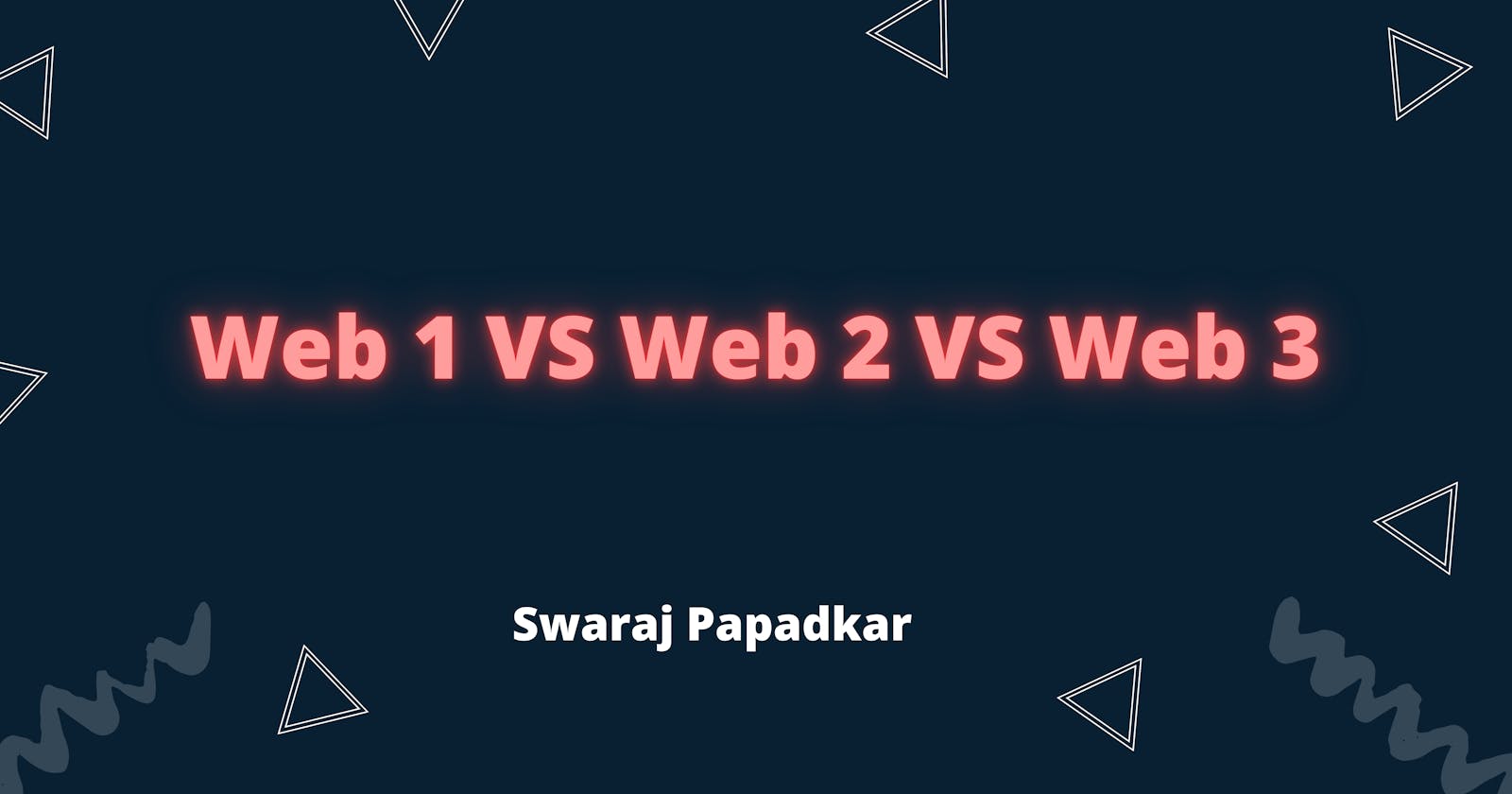Web 1 VS Web 2 VS Web 3
Let's understand the difference between Web 1, Web 2 and Web 3.
Have you ever thought about how the web has evolved from what it was before 10 - 20 years ago VS the web that we are experiencing today?
The Web is a commonly used term for World Wide Web which is a collection of webpages found on a network of computers known as the internet.
In this article, we will try to understand the history of the web, how the web has evolved and where is it going next.

Web 1.0
It all started in the year 1993 - 1994 when the web became available for the general everyday use. The people who used web during this era were mostly consumers. The content creators were comparatively fewer, typically developers or researchers who built websites to share information in mainly text or image format. This was the very first iteration of the web which lasted approximately from 1991 to 2004, and is now commonly known as Web 1.0.

The content on websites during this era was mostly static or in simple terms read-only, and websites didn't have much interactivity at all.
Web 1.0 is also known as the Static Web.
Web 2.0
In the year 2004 it all changed as Web 2.0 was introduced. Web 2.0 refers to the version of the internet most of us know today. With this version of the web, interactivity between users and websites have increased, web pages have become dynamic i.e. it can serve different content for different users, and with the introduction of social media users don't have to be a developer to participate in the process of content creation.
Think of it like this, users who were only able to view images on websites are now able to post and share their lives with the world where millions of people can see it, interact with it, and comment on it.

Web 2.0 is great and we enjoy using it on a daily basis (YouTube, Twitter, Facebook, etc). But, there are few flaws in it.
All the websites built using Web 2.0 are centralized which means behind every website or app there is a central official institution which has the full power over the content that we post, share and comment on.
This means although the content is created by many and consumed by many, it is owned only by a few and in order to gain profits from this information collected from the users, these institutions can exploit this information for personalized advertisements or can even sell personal data of users.
Another major flaw with applications using Web 2.0 is with security and privacy. As big amount of user data is owned by a single entity, it can become a prime target for hacking and data breaches.
Web 2.0 is also known as Social Web.
To solve this shortcomings Web 3.0 came into existence.
Web 3.0
Web 3.0 introduces decentralization which roughly means that the content created by users will be separated and stored on a large number of computers which are not owned by one company and instead each user can own a small amount of data so that it is fully transparent and no official institution can have full control over it.
Because of this, even though the websites or applications are owned by a certain company, the content created by users will always belong to the users and users will be able to own their data.
There are different ways for achieving decentralization like decentralized networks of many peer to peer nodes (servers) and blockchain.
Web 3.0 is also known as Decentralized Web.
Blockchain is the most well-known solution and Bitcoin and Ethereum are the two major blockchains in existence.

When we hear about blockchain, generally cryptocurrency comes to our mind. This is because it plays a very important role as it is used to provide financial incentives, known as Tokens for anyone who participates in creating, governing, contributing to, improving one of the applications or even for being early adapters of the applications.
Tokens are easy to transfer and can be sent directly from the provider to the user without any need of other third party services like Stripe or Paypal. Users can also make a living by participating in the protocol in various ways, in both technical and non-technical levels.
The famous NFTs are also tokens but like paintings they vary in their values and are unique. If you're interested in getting into it you can check out Opensea for more information.
This token economy is exactly what the web was created for in the first place. It's direct. People reward people for providing a service or participating in a better world. There is no malicious data tracking or manipulation. No exploitation, no incessant ads, no algorithms designed to be addictive. No reliance on huge profit-driven companies. Just people interacting with people. That's web3. - Cat McGee
Conclusion
Most applications that we are using today are based on Web 2.0, but applications built using Web 3.0 have slowly started picking up the pace and are beginning to enter huge industries like music, video streaming, and gaming.
If you are interested in getting involved and exploring blockchain applications as well, the only thing you will require is a crypto wallet like Metamask and you are good to go.
This is my very first article and I hope I was able to provide you with some valuable information through this article. Thanks for reading. I am learning more about web 3.0 and web development, if you're interested in being a part of this learning journey feel free to follow me here or on twitter.

